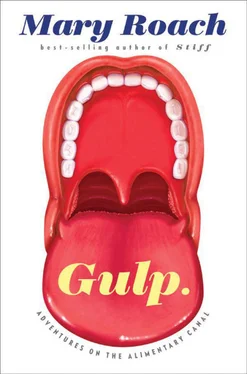If you must spend time in a digestive organ, I recommend the penguin stomach. Penguins can shut down digestion by lowering the temperature inside their stomach to the point where the gastric juices are no longer active. The stomach becomes a kind of cooler to carry home the fish they’ve caught for their young. Penguins’ hunting grounds may be several days’ journey from the nest. Without this handy refrigerated mode, the swallowed fish would be completely digested by the time the adults get back—“like going shopping and eating everything you bought on the way home,” as marine biologist Terrie Williams put it.
ONE REASON THE notion of living principle gained traction in John Hunter’s mind was that it offered a medical explanation for stomach snakes. As far back as Babylon and ancient Egypt, people had been coming to doctors with complaints of reptiles or amphibians living inside them. The malady hit an especially brisk stride in the late eighteenth century. “Thence it is,” wrote Hunter in his 1772 paper on the living principle, “that we find animals of various kinds living in the stomach, or even hatched and bred there.” Through the end of the century and likely beyond, biologists of imposing stature—not just Hunter, but also Carl Linnaeus—believed that frogs and snakes could live in humans as parasites, nourished by daily deliveries of swallowed food. Medical historian and author Jan Bondeson tracked down some five dozen case reports in medical journals from the seventeenth, eighteenth, and nineteenth centuries. Eighteen involved lizards or salamanders; seventeen posited snakes; fifteen claimed frogs; and twelve toads.
Despite the varied taxonomy and geography represented by these cases, the basic premise is more or less the same. The patient, vexed by odd sensations or pains in the abdomen, suddenly remembers a visit to the country. While walking home at night, the tale typically goes, he stops to drink from a pond—or marsh or rivulet or spring. It’s nighttime, and he cannot see what he is swallowing. Or he is drunk and does not notice. Sometimes he believes he swallowed eggs, other times the actual animal. In a few instances, the person lies down to sleep or passes out, whereupon some elongate, cold-blooded creature slithers down his esophagus and into his gut.
What cements the delusion, in the patient’s mind, is the timely sighting of an animal in the chamber pot. “When at stool, she had unusual pain in the rectum, and afterwards she thought she perceived something moving in the pot,” reads a typical case report, from 1813. Often the patient has been given a cathartic to relieve his symptoms. As here, in the 1865 case report of a stomach slug: “The patient had taken an injection per anum [60] Meaning “by way of the anus.” “Per annum,” with two n ’s, means “yearly.” The correct answer to the question, “What is the birth rate per anum?” is zero (one hopes). The Internet provides many fine examples of the perils of confusing the two. The investment firm that offers “10% interest per anum” is likely to have about as many takers as the Nigerian screenwriter who describes himself as “capable of writing 6 movies per anum” or the Sri Lankan importer whose classified ad declares, “3600 metric tonnes of garlic wanted per anum.” The individual who poses the question “How many people die horse riding per anum?” on the Ask Jeeves website has set himself up for crude, derisive blowback in the Comments block.
… and immediately afterward something attracted his attention by moving about under his clothes.”
The likelier chain of events, of course, is that the creature had been in the pot or the bed, unnoticed, all along. And that the authors who wrote these papers were either lazy thinkers or, equally possible, crafty career opportunists. Cases like these, taken at face value, were irresistible medical curiosities; reports of them were sure to be published in medical journals and newspapers of the day, spreading the physicians’ names and boosting their status.
Then again, to be fair, some of the details conspired to lend credence to the claims. Like the contemporary urban myth, tales of stomach frogs and “bosom serpents” persisted because they have truthiness. Few would believe a story about a man with a mammal alive in his digestive tract—though Bondeson tracked down one instance of a stomach mouse—but an indwelling frog has biological plausibility. Sideshow regurgitators used frogs because they can absorb oxygen from water through their skin. Swallow a frog in a large glass of water, and it will survive—at least through the end of the act.
Cold-blooded animals in general have lower metabolic needs. Because they’re not using food energy to heat themselves, they manage with less. Some frogs all but shut down in winter. “I wouldn’t be surprised if live frogs were gutted out of bass in winter, by fisherman,” wildlife biologist Tom Pitchford told me. But a human belly isn’t cold. It’s tropical. Around 1850, in Germany, physiologist-zoologist Arnold Adolph Berthold, seeking to put an end to stomach-frog folly, put some northern European species of frogs and lizards in body-temperature water. The adults died, and the spawn putrefied.
That snakes top the list is not surprising. On top of their overall cold-blooded hardiness, they seem to have a special knack for enduring gastrointestinal confinement. Phillip Clapham, the whale biologist I pestered at the start of this chapter, related the story of Gracie, a Doberman mix who once vomited a two-foot garter snake onto Clapham’s dining room floor during a dinner party. As he tells it, his wife at the time, assuming the snake was dead, picked it up in a wad of paper towels and then “nearly dropped it when its little forked tongue came out.” Clapham insists Gracie hadn’t been outside for at least two hours. “It had been in there quite a while.”
University of Alabama snake digestion researcher Stephen Secor once watched a king snake regain consciousness after somewhere between ten and twenty-five minutes inside another king snake. He had put the two in the same tank, not realizing one species considered the other dinner. Secor left the room, and when he returned, dinner was “down in.” He pulled them apart, and was relieved and surprised to note that dinner still had a heartbeat.
Nonetheless, a brief sojourn is different from permanent immigration. More reputable doctors of yore recognized stomach snakes for what they were: delusions inspired by gastric symptoms. The underlying condition was typically mundane: ulcer, lactose intolerance, intemperance, gas. You could often tell what was going on from the patients’ descriptions of their tenant’s habits. Andrew S.’s snake acted up whenever he drank alcohol or milk. “He will never allow me to drink whiskey,” S.’s physician Alfred Stengel quotes him as saying in the 1903 paper “Sensations Interpreted as Live Animals in the Stomach.” “He hates that worse than anything else.” The stomach snake of a woman in Castleton, Vermont, circa 1843, was most active after “any considerable indulgence in gross food.”
Occasionally there was nothing wrong at all, just the ordinary grumbling and gurgling—the borborygmi—of the gut. The surgeon Frederick Treves, writing in the late 1800s, described five cases of patients complaining of wriggling movements or of live snakes inside them. Upon operating and finding nothing beyond the normal motions of a healthy digestive tract, he coined a term: “intestinal neurosis.” It exists today, minus the snakes. One gastroenterologist told me about a sad soul who wandered the motility clinics of North America with a video of himself in his underwear, pennies stacked on his abdomen to show the alarming motions of his (perfectly normal) intestines.
Читать дальше












